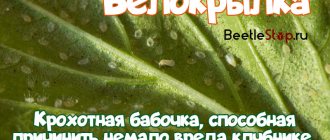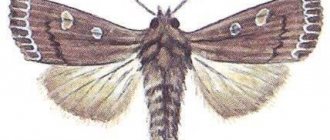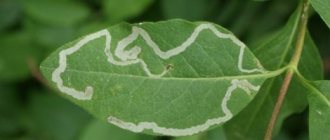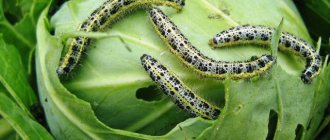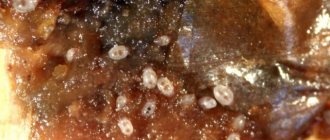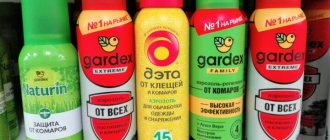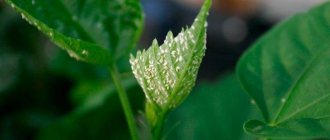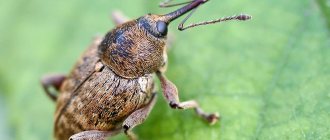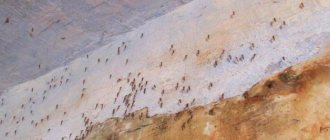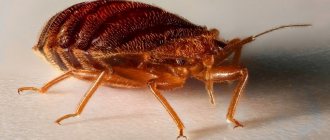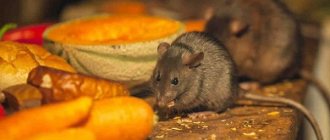Causes of the pest
Even if there was a healthy harvest of berries last year, this does not guarantee that the insect will not appear on the site this summer or next. The instincts of pests are to reproduce and lay eggs. And they can fly from a neighbor’s garden, as they have an excellent sense of smell and can smell sweet berries from a great distance.
By the way, most methods of repelling this pest are based on changing the aroma of the fruit, making it less attractive to pests.
No one is safe from the appearance of a pest. In most cases, this pest plagues gardeners from the southern regions. But it can start in the north. Therefore, it makes sense for every owner of fruit trees to prevent the appearance of this insect.
Preventive measures
Fighting the cherry fly on cherries and other fruits takes a lot of effort and time. Therefore, it is advisable to take several preventive measures that will prevent the appearance of the pest:
- With the arrival of spring, be sure to dig up the tree trunk circle to a depth of 30-40 cm . So, you pull the larvae out of the ground, and they will die from the cold. Also hold a similar event in late autumn.
- Use infusions of tobacco and wormwood to kill aphids . These insects provide food for flies, and without them the pests will have nothing to eat.
- And it is also useful to plant marigolds, lemon balm or marigolds . Such plants repel aphids.
- Take a thorough approach to harvesting . Try to collect all the berries from the trees so as not to leave fruits with larvae.
- Immediately remove any berries that fall from the trees . Throw the carrion outside the site, burn it or bury it in the ground, but to a depth of at least 0.5 meters.
- And finally, if you spray trees, be sure to treat the ground underneath them as well . This will destroy most of the larvae.
Insect lifestyle and reproduction
For wintering, the pupae go 3–5 cm deep into the soil. In the spring, when the surface of the earth 5 cm deep warms up to 10 degrees, young flies emerge from their hiding places.
Males are born first, and females appear later - after 4-5 days.
The emergence of young flies in the southern regions continues from mid-May to mid-July. The reddish-gray and sluggish insect has an underdeveloped reproductive function. In the first few days, the female needs increased nutrition: juices secreted from cracks in leaves, trunks and fruits, sweet secretions of aphids and leaf flea beetles. After 2–3 days, having grown stronger, the insects begin mating.
Mating occurs in warm sunny weather at a temperature not lower than 18 degrees. After 7–10 days, the female lays eggs. To do this, she looks for suitable places, carefully studying each fruit. Both ripe and still green berries are suitable. Having positioned the ovipositor perpendicular to the surface of the fruit, the female pierces it and lays eggs in the nutritious pulp. The whole process lasts no more than 4 minutes. The lifespan of a female is about 1 month. During this time, she lays up to 150 eggs - 1 egg in each fruit.
The development of the larva in the egg occurs within 7–10 days. After this, the larva continues to live in the berry and feed on its pulp. This stage lasts 15–25 days. The strengthened larva falls to the ground and, burrowing into the surface layer of soil, turns into a pupa. The insect remains in this state until the spring of next year.
14% of pupae end up in unfavorable conditions, which delays the further development of the pest for several years.
If you want to get rid of pests effectively, but without using chemicals, then attract insect riders to your gardens.
Prevention
Getting rid of a pest is much more difficult than preventing its appearance. The most reliable method of protecting fruit trees is careful implementation of preventive measures:
- timely destruction of other insects - aphids, carrion, which are food for the cherry midge;
- digging up the soil around the tree three times during the growing season to get rid of pupae;
- preventive irrigation of late varieties with Actellik;
- quick and complete collection of ripe berries;
- cleaning up carrion, dry branches and leaves under the tree.
It is recommended to plant calendula, garlic, and mint near fruit trees. These plants with a strong aroma will repel insects
The cherry midge is a dangerous pest that can completely destroy the fruits of fruit trees. It needs to be combated comprehensively, using chemicals and natural remedies to spray the crown and soil around the plant. But it is best to prevent the appearance of the pest by taking preventive measures in a timely manner.
Is it possible to eat wormy cherries?
If you don’t break the cherries, you may not even notice the worms in them. Usually, when larvae are discovered, the fruits are thrown away. Worms are safe for human health; they do not cause diseases or other problems in the body. If the fruits are fresh, you may not notice a change in taste. When a cherry tree has been hanging on the branches for a long time, this is reflected in its qualities. The taste of such berries deteriorates and bitter notes appear in it.
The main question that worries gardeners is what to do if the cherry fruits are wormy. A simple method will help save the harvest. The collected berries are dipped in 3 liters of water, where 3 tsp are dissolved. salt. First, the fruits are inspected and their tails are removed. This will allow the liquid to penetrate into the middle of the cherry faster.
Soaking the crop is the only safe way to get rid of worms and preserve the appearance of the crop.
To treat the harvest from worms, the fruits are dipped in salted water so that it completely covers them. It does not need to be heated or cooled; room temperature liquid will do. The container is left for half an hour. As a result, the worms will come out of the pulp and end up on the surface of the water. The cherries are placed in a colander and washed under running water. After such processing, the fruits are consumed fresh, used for canning or freezing.
Instructions
Boil milk and add vanilla sugar, butter and a teaspoon of lemon zest. Stirring thoroughly, slowly pour semolina into the milk. Afterwards, remove the pan from the stove and leave the semolina to swell.
Add raisins and egg yolks to the swollen and cooled semolina. Beat everything with a mixer. Beat the whites together with sugar and add to the semolina mass, mix everything with a mixer until smooth. Next, place on a baking sheet and place in the oven to bake at 160 degrees for 40-45 minutes until golden brown.
To make the sauce, you need to pour sugar into a frying pan and melt it. Add butter, half a glass of cherry juice and mix everything. Add starch to the remaining cherry juice and pour into the pan. Add liqueur and whole cherries there. Mix everything. Serve the casserole in small square pieces and top with a small amount of cherry sauce. Bon appetit!
What harm does the insect cause?
If measures are not taken in time, you can lose about 80–90% of the entire harvest of cherries or cherries. For this pest, the threshold of harmfulness is calculated by the number of affected berries out of the total volume of fruit. When more than 2 berries per 100 are affected, it is necessary to urgently take measures to save the garden. A large number of viable larvae can destroy the harvest of not only cherries, but also honeysuckle, snowberry, barberry, and apricot.
Affected berries lose their shape and shine, become soft, quickly turn black and crumble. You shouldn’t eat them, but to make compotes and jam you’ll have to soak them in salted ice water for a long time. Experts say that in water the larvae will leave the berries and float to the top, but one cannot completely count on such cleaning. The taste of the fruit becomes bitter, and the larvae remaining in them can seriously spoil your appetite.
Common mistakes gardeners make when caring for cherries
All crops in the garden require constant care.
In the case of cherries, the main agrotechnical measures are: watering, fertilizing, weeding, grafting and regular pruning. If basic norms are not observed, the intensity of fruiting changes and it ceases to be abundant. Rare and scanty watering is dangerous for cherries, especially during the active growing season. Lack of moisture is felt in the shoots. Against this background, the risk of buds freezing in winter increases, which reduces the harvest volume in the next season.
It is equally important to feed the tree on time. The lack of mineral components affects the condition of the plant, it reacts worse to climate changes, becomes fragile and painful
Other recommendations worth considering:
- cherries are loved by pests, but the situation can be corrected by making a bird cherry rootstock;
- avoid thickening the crown, carry out regular pruning, it will help increase productivity, the branches will receive sufficient light;
- For productive self-pollination, plant two cherries next to each other (or cherries).
Treatment of cherries against pests attacking them should be carried out before flowering. This is the main condition to prevent insect attacks and preserve the harvest in the coming season.
In critical situations, it is permissible to carry out the procedure during the flowering phase, but the harvest can be harvested no earlier than 20 days later. At the same time, harmful substances may remain in the fruits.
There are quite a lot of cherry pests that are active in garden plots. All of them are capable of causing significant damage to garden crops, and after their activity it is almost impossible to correct the situation.
The problem can be prevented by following certain rules; the main thing is to treat the garden with insecticides two or three times in early spring. If the remaining recommendations are followed by the gardener, the effectiveness of the drugs will be sufficient and the risk of damage will be reduced to a minimum.
Elena Vasilyeva
When to spray cherries against cherry flies
Approximate time frame for treating cherries against cherry flies:
- in early spring;
- during the flowering period;
- at the beginning of fruiting.
Treatment in early spring will help get rid of cherry fly pupae, from which worms later emerge. It is carried out after the snow melts and before the buds swell. If the timing of the first spraying is missed, it can be done during the flowering period and at the beginning of fruit ripening.
First, cherry flies are identified using traps. Buy adhesive tape at the garden store. However, you can make the bait yourself: mix 2 tbsp in one container. l. castor oil, 1 tbsp. l. rosin and honey (jam). The mixture is heated and stirred until the ingredients are completely dissolved.
Then take a sheet of plywood or cardboard and paint it yellow. The resulting mass is applied on top. The honey attracts the cherry fly, and the sticky mixture prevents it from flying away and laying larvae in the cherry. It's better to make several traps and place them around the garden. If the number of flies on the plywood exceeds 20, then immediately begin spraying the cherries.
More often, worms appear in cherries of mid-late and late varieties. Early varieties manage to produce a harvest before the fly appears.
When using chemicals against worms, treatments are carried out no more than once every 2 weeks. All spraying is stopped 3 weeks before harvesting. It is better to choose a cloudy day when there is no rain and strong wind. It is possible to postpone processing to morning or evening. The main condition is the absence of direct sunlight, which causes burns on the leaves and flowers of the cherry.
Preparations for treating plants
The best way to get rid of insects is to use commercial preparations. But each of the chemical compositions is used at different times - before or after the appearance of color. They must be used strictly according to the instructions.
Products used before and after tree flowering
The following preparations are used for spraying until color appears:
- Inta-Vir;
- Fufanon;
- Confidor;
- Mospilan;
- Aktellik;
- Karate;
- Spark.
The first spraying is 10-12 days after the insects fly out, and then again 2 weeks later. Insects gradually become accustomed to one chemical, eventually ceasing to react to it. Therefore, drugs must be alternated.
Additional Information! For medium and late ripening varieties, these solutions can be used even after the ovaries have been formed.
After the tree has finished blooming, Lepidocin and Bitoxibacillin are used.
How to get rid of a pest
There are several methods for controlling cherry flies in the garden. The earlier the parasite was noticed, the greater the chances of getting rid of it. Crops can be treated with insecticides, biological preparations, and folk remedies. If the number of insects is small, do-it-yourself traps using improvised materials will help deal with them.
Traps for harmful insects
Traps with bait can be used in spring and summer, during the egg laying period. They can be adhesive or liquid based. For the latter, tin cans or plastic bottles painted yellow are used. A sweet, aromatic liquid is poured into such traps, which is guaranteed to attract insects with its smell. The cherry fly will fly to the smell, but once inside the container, it will not get out.
Can be used:
- still lemonade or fermented juice;
- kvass;
- jam with water;
- honey solution
As for glue traps, you can make them yourself. It is enough to cut several long strips of thick cardboard, paint them lemon color and cover them with any long-drying glue (for example, ALT). The baits are hung on trees at a short distance from each other and changed every 2-3 days. Cardboards with glued flies are burned. A large number of insects requires a serious approach; glue traps cannot correct the situation. Only double treatment with insecticides will help. There are several such tools that have proven their effectiveness.
Insecticidal preparations
The most popular product is Actellik, produced in the form of a concentrated 50% emulsion for dilution with water. The active substance is pirimiphosmethyl. The drug is toxic to bees, but does not pose a great danger to people and animals. The working solution is prepared according to the instructions by dissolving 2 ml of emulsion in 2 liters of water. One tree requires 2–4 liters of the prepared solution; spraying begins 20–25 days before harvest.
One of the popular drugs is “Iskra Double Effect” in tablets, designed to combat 60 types of fruit pests. The product is based on two main insecticides: permethrin and cypermethrin. Dissolve 1 tablet of the drug in a bucket of water and treat the trees during the flowering period. You need to spray again with Iskra after 15 days.
Liquid "Aktara" and "Aktofit" are successfully used in the fight against most known pests. They are an odorless emulsion with thiamethoxam or aversectin as the active component. A solution is prepared from 1 ml of the substance and 5 liters of water, the treatment is carried out both on the leaves before flowering and at the root. The drugs also work well against cherry aphids, which are the main source of nutrition for the adult fly.
"Fufanon-nova" is also effective against cherry fly, but is toxic to people. It is a water-soluble emulsion for preparing a solution. Available in small ampoules of 2 ml (per 1.5 liters of water) and 6.5 ml (per 5 liters of water). Each tree will require about 5 liters of the prepared solution; it is used during the flowering period. The composition includes malathion; you can work with the product only in protective clothing and for no longer than 3 hours in a row.
The insecticide "Calypso" with thiacloprid as an active ingredient has the same effect. Available as a liquid concentrate in ampoules of 2 ml. Absolutely non-toxic to bees, fish, people and animals, but it is not recommended to work with it in the heat or immediately after rain. Used at the rate of 1 ampoule per 10 liters of water, the finished solution is enough for 100 sq. m.
Emulsion "Zolon" is a 35% concentrate of fozalon, produced in ampoules of 5 or 10 ml. 10 ml of the substance are dissolved in 10 liters of water and a solution is obtained that can be sprayed on plantings (100 sq. m) during the growing season, not during flowering, at the latest - 30 days before harvest. The finished liquid is poured into a container with a spray bottle and sprayed onto the cherry crown. The drug is effective against most garden parasites.
“Alatar” will help defeat the pest. Contains malathion and cypermethrin, available in 5 ml ampoules. To treat 1 tree, you will need 2–5 liters of ready-made solution (at the rate of 5 ml/5 liters of water), depending on the age.
Infusions from “grandmother’s box”
Non-aggressive methods of controlling cherry flies have been used for a long time. Traditional decoctions in this sense are decoctions of wormwood, as well as infusions of tobacco leaves. You can even make a concentrated soap solution and spray the trees. It is harmless to trees, but creates a film on them that garden pests do not like. At the same time, please note that such remedies are primarily aimed against cherry aphids. It will be definitely destroyed, which means there will be significantly less cherry flies in the treated area.
Now you know how to deal with cherry flies. We have described the most popular and accessible methods, the effectiveness of which has been tested many times. If you have your own options for solving the problem with this pest, please share. We really appreciate your comments - live dialogue with readers is very important for the development of our resource.
Folk remedies and ways to combat cherry flies
Amateur gardeners have been growing cherries for years, so they have their own secrets for preserving the harvest and fighting the cherry fly. They are usually based on the preparation of spray formulations. The operating procedure is usually as follows:
- Take the plant material, place it in a saucepan with water and bring to a boil.
- Treat the trees with the cooled infusion using a sprayer, repeating the procedure every time after rain.
The following are used as plant raw materials:
- pine branches;
- tobacco;
- garlic;
- sagebrush;
- onions, etc.
There is no strict dosage of components, and each gardener usually has his own recipe. So, tobacco infusion is often made like this:
- For 10 liters of water take 0.5 kg of dry tobacco.
- Pour hot water over the raw materials and leave for a day.
- Boil the infused mixture for an hour.
- Strain.
- Before treating the trees, add 40 g of grated soap to the cooled infusion and dilute the resulting composition with water - 1 part product to 2 parts water.
Reviews
In order to preserve the harvest of cherries and cherries, it is better to worry about the destruction of the main pest of these trees - the cherry fly - in advance. If insects appear, use the traditional and chemical methods described above to combat them.
Sources
- https://MoeFermerstvo.ru/vishnya/muha
- https://VrediteliSOS.ru/sadovyie/komnatnyih-rasteniy/vishnevaya-muha.html
- https://beetlestop.ru/vishnevaya-muha/
- https://vaskindom.ru/raznoe/metody-bor-by-s-vishnevoy-muhoy-sroki-obrabotki-vishni-i-chereshni-ot-nee-preparaty-i-lovushki.html
- https://ogorod365.com/borba-s-vishnevoj-muhoj-sroki-obrabotki-effektivnye-preparaty/
- https://AgroGnom.ru/berries/sweet-cherry/kak-izbavitsya-ot-chervej-v-chereshne.html
- https://belt-wrestling.su/mol/borba-s-vishnevoj-muhoj.html
- https://vreditel-stoi.ru/sad/vishnevaya-muha.html
- https://OgorodGuru.com/bolezni-i-vrediteli/vishnevaya-mukha
[collapse]
Diseases of forage legume grasses
Cancer. The causative agent is Sclerotinia trifoliorum, division Ascomycota.
Symptoms: In the spring, during the regrowth period, the leaves of diseased plants acquire a silvery tint. On rotting organs, aerial white mycelium and black tuberculate sclerotia are formed. The root collar and roots turn brown and become watery. The above-ground part is easily torn off from the roots.
Sources of infection: mycelium on plants and sclerotia in the soil, fragments of mycelium spread.
Fusarium. The causative agents are fungi of the genus Fusarium, division Deuteromycota.
Symptoms: dark brown dry or wet rotting spots on the upper part of the main root or on the lateral roots. The core part of the root is destroyed, becomes rotten, and the plant dies. On the cross section, browning of the vessels is noticeable. With high humidity, a pinkish-white fluffy coating and whitish, pale pink mucous pads appear at the base of the affected stem. Sources of infection: persistence of chlamydospores and sclerotia in the soil.
Anthracnose. The causative agent is Colletotrichum trifolii, division Deuteromycota.
Symptoms: streaks and dark spots on sprouts, cotyledons and young stems. On adult plants there is a net pattern, which later gives way to brown spots. On the stems and petioles of leaves there are dark, slightly depressed streaks that grow into oblong brown ulcers with a black border.
Sources of infection: conidia and mycelium on plant debris and seeds, spread by conidia with water and wind.
Rust. Pathogens: on clover - single-host Uromyces fallens, on alfalfa - Uromyces striatus with an intermediate host spurge, department Basidiomycota.
Symptoms: Bright orange aecia form on the undersides of clover leaves. By the beginning of flowering, brownish urediniopustules are formed. At the end of the growing season, black-brown telopustules form. Sources of infection: with clover rust, uredinio- and teliospores on plant debris and living leaves, with alfalfa rust - mycelium in the rhizomes of milkweed, urediniomycelium on wintering alfalfa.
Powdery mildew. The causative agent is Erysiphe communis, f sp. trifolii on clover and f. sp. medicaginis on alfalfa, division Ascomycota.
Symptoms: white powdery coating on the leaves, petioles and stems of plants in the second half of summer. Sources of infection: cleistothecia, mycelium, spread by conidia by wind.
Brown spot. The causative agent is Pseudopeziza medicaginis, division Ascomycota.
Symptoms: brown round spots with jagged-fringed edges appear on the leaves. There are oblong brown spots on the stems, petioles and beans. In the center of the spots, brown wax-like tubercles develop - apothecia. Sources of infection: apothecia and pycnidia on diseased plants, spread by conidia with rain and wind.
Bacterial wilt. Caused by several types of bacteria, most commonly Clavibacter michiganensis pv. insidiosus.
Symptoms: diseased plants have inhibited growth and chlorosis. On a transverse section of stems and roots, darkening and necrosis of blood vessels are noticeable, on a longitudinal section there are streaks or stripes of brown color in the conductive system. Preserved in the tissues of perennial plants.
Clover phyllodes. The causative agent is the phytoplasma Candidatus phytoplasma trifolii.
Symptoms: flowers in inflorescences grow and turn into leaves, witches' brooms are formed, plant dwarfism. No seeds are formed. Preserved in the tissues of perennial plants.
Alfalfa mosaic. The causative agent is the alfalfa mosaic virus. Sick plants with inhibited growth, chlorotic. The leaves have a greenish-yellow mosaic, deformation. There are narrow necrotic stripes on the edges of the leaves. Preserved in the tissues of perennial plants, transmitted by different types of aphids, with seeds.
Dodder of clover and alfalfa. The causative agent is Cuscuta trifolii, C. campestris, C. epilinum. Dodder stems, like thick wires, wrap around the stems and leaf petioles of clover and alfalfa plants. In places of contact with the plant, suckers are formed on the stems of the parasitic plant. The stems can be reddish, pink, yellow, greenish with a pink tint, their thickness is 0.8-2.5 mm. Dodders cause metabolic disorders in host plants, weaken and delay their growth and development, and contribute to a decrease in crop yield and its quality, as well as winter hardiness. Distribution occurs with seeds of cultivated plants, animals, cars, water, wind, manure, planting material, etc.
Protection methods
When deciding how to treat the plant and what to do to protect your cherry tree, you should find out the ripening dates of your variety and choose which method of control you prefer - folk, mechanical or chemical. However, regardless of the means, a number of agrotechnical treatment and preventive procedures should be carried out, including:
- from spring to autumn, loosening the soil should be done at least 15 times, and deep digging - 3 times;
- It is recommended to spray protective agents not only on the trunk and branches, but also on the root soil;
- timely harvesting of the entire harvest will protect the cherries from rotting, which is a good environment for the development of the cherry fly;
- regularly remove fallen leaves and dry branches from under the tree;
- fight other parasites and infectious diseases.
After carrying out treatment and preventive procedures, you can begin to use other means of exterminating the pest.
Traps
Traps can be of two types - liquid and glue. Both types can be made independently. Mechanical traps are suspended from tree branches.
For a liquid trap, as a rule, an empty vessel (can of cans, paint) is used, onto which the top of a plastic bottle is placed. The jar is filled with a sweet-smelling liquid (soda, compote, kvass). The fly flies in through the spout and is no longer able to get out.
Glue traps are made simpler: a sticky composition is applied to any object, and this object is suspended from a branch.
Chemical treatment
You can spray cherries with light insecticides: “Aktellik”, “Phasis”, “Iskra”, “Molniya”. Treated cherries will not be harvested for the next 3 weeks. Treatment is carried out using a spray bottle. To prevent the pest from becoming accustomed to the drugs, the drugs are alternated.
Effective infusions
In mid-spring, wrapping the tree in agrofibre is effective, and after the pest appears, the tree can be sprayed with infusions of strong-smelling herbs - garlic, pine needles, wormwood.
Prevention, good care and timely action are the key to effectively curing a tree from cherry flies.

